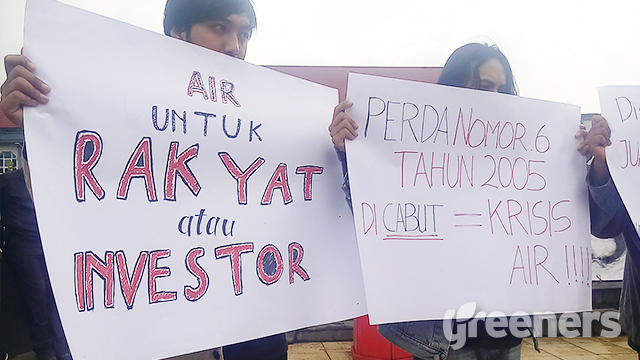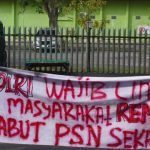Malang (Greeners) – Two months away from East Java regional election, green watchdog slammed the candidates for excluding environmental issues, especially on water resources in the province.
Indonesian Forum for the Environment East Java (Walhi Jatim) chapter revealed that as a heavily populated region and nation’s paddy supplier, the province’s water quality decreasing every year is affecting agriculture sector.
“East Java’s dependent on good quality of water is absolute,” said Rere Christanto, its executive director in a press release, on Thursday (22/3).
Based on Environmental Management Quality Index of East Java in 2016, water quality was recorded 52.51 in 2015 and decreased to 50.75 in 2016, or Very Concerning. In addition, national strategic rivers, such as Brantas river in East Java was 49.17 and 47.68 in 2015 and 2016, respectively. Meanwhile, Bengawan Solo river in Central Java was 48.75, making the two rivers in Alert status.
READ ALSO: JATAM : Regional Election Triggers Mining Permits Issuance in Indonesia
Another water quality monitoring, conducted by East Java Environmental agency, Perum Jasa Tirta, and Irrigation Agency of East Java, stated that rivers in the province contain 87.4 percent of Biological Oxygen Demand (BOD) concentration, 49 percent of E. coli, 55.98 percent of fecal coliform, 7.2 percent of Chemical Oxygen Demand (COD), and 65 percent of Total Suspended Solid, these numbers are exceeding standards for Class II River Quality.
Walhi said the decreasing water quality was direct impact from environmental crisis, upstream and downstream. In upstream area, such as Malang Raya comprises of Malang district, Malang city and Batu city, have been critically degrading. The water supplies and demands in area showed critical condition.
In Malang district, there were 873 springs with water surcharges range between one liter to 4,000 liter per seconds in 2008. At least a third of these springs have been depleting. Similar decreasing also happened in Batu city which used to have 111 springs. Out of 57 springs in Bumiaji sub-district, there are only 28 remaining. Meanwhile, in Batu sub-district, there are only 15 out 32 springs, and Junrejo sub district only has 15 out of 22 springs.
READ ALSO: Crash Course on Eutrophication of Jakarta Bay
Degrading water catchment areas including protected forest and areas due to forest use changes to settlements and tourism investment (for entertainment parks, hotels, villas, and others) are the major drivers for the damages in upstream areas.
Currently, 800,000 hectares of forest areas in East Java has been destroyed, — 250,638 hectares in Brantas Watershed, 286,102.12 hectares in Sampean Watershed, 270,296.79 ha in Bengawan Solo Watershed –, calling for integrated restoration effort for water quality in the province.
In downstream area, based on the region’s environmental agency site, there are 1,004 industries potential to polluting the whole province as 483 industries located in river banks of Brantas Watershed.
Lack of monitoring and legal enforcement have been the obstacles for water quality restoration in East Java. The report on environmental performances of East Java, locally known as IKPLHD, in 2016 stated that BOD concentration for liquid waste reaches 5,588 tons per year, COD concentration at 14,541 tons per year, TSS reaches 1,493 tons per year, ML 21.1 tons per year and ammonia 99.73 tons per year.
The numbers were far below factual number as the report only included pollution from 85 industries participating in the PROPER assessment. Latest report from Ministry of Environment and Forestry on Water Quality 2013 – 2015, showed that all rivers in East Java are categorized as Heavily Polluted.
The data on water quality of East Java should have been encouraging for candidates to prioritize water protection and restoration.
“Nevertheless, water is main needs of people. Without good quality of water, you cannot possible achieve better development in East Java,” said Rere.
Water Day Action in Brantas Upstream
To commemorate Water Day, dozens of activists stage a demo criticizing spatial planning policy issued in 2011 of Batu city administration, claiming that the 20 years development plan will hit the city’s water supplies.
Pradipta Indra Arion, the protest’s spokesperson, said the plan involved additional land use changes of a total of 1,060.87 hectares for settlements, trade/service, office, industry and tourism, meanwhile areas allocated for food and horticulture are decreasing up to 1,682.64 hectares.
The action demanded for the government to open up public consultation on revised plan of the spatial planning.
Reports by HI/G17



















































